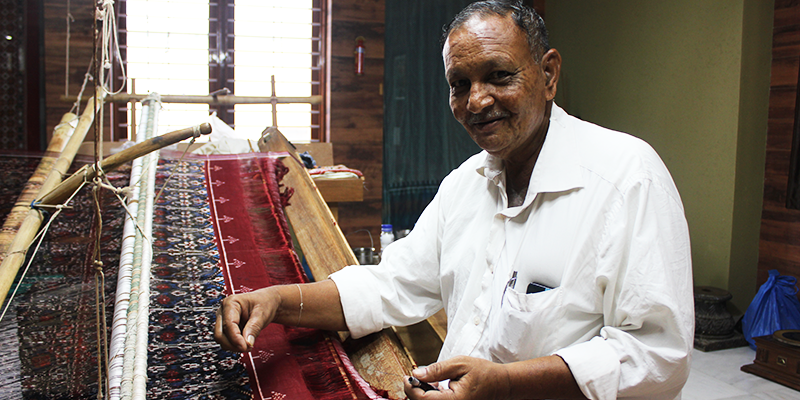The story of Patan Patola: A fabric that never fades and one family’s tryst with keeping it alive
Today, getting a product out quickly is pivotal to success for most business, especially for consumer- facing ones. But, the business of one craft defies this norm to survive and succeed.
We are talking about the Patola sarees of Patan. It takes the combined effort of four weavers anywhere between four to six months, sometimes even more, to weave a single saree. This unique weave, usually made from silk, is a double Ikat and combines the techniques of tying, dyeing and weaving.
Many consider Patola as the ‘ultimate manifestation of weaving perfection’ because the displacement of even one thread can resulted in a deformed pattern. Also, the dyeing and the weaving process is extremely complicated, requiring mathematical precision coupled with a vivid imagination. The double Ikat weave means once the saree or fabric is woven, you cannot differentiate between the sides – the colour and the intensity, the feel and the look, are the same on both sides.

“Patola weaving requires a lot of mental calculations, patience, undivided attention and dexterity of the hand. A computerised machine or powerloom cannot be of much help here,”
says Rohit bhai Salvi, a master craftsman, and a member of one of the three surviving families who are practising the Patola weave. Rohit bhai belongs to the 16th generation of a family that has been pursuing this weaving art form.
A touch of history and geography
The fame, charm, and the popularity of the Patola sarees have been woven by centuries of rich history. From a mention in the Kalpsutra, a 2000-year-old Jain holy book, to carvings in the Ajanta caves, and numerous folk tales in different languages – from Gujarati to Telugu, the Patola sarees make for a fascinating subject. In fact, it took 34 years of constant research for two Swiss writers, Alfred Buhler and Eberhard Fischer, to pen a book The Patola of Gujarat. The book was published in 1979.
The art of Ikat which is integral to Patola has been popular in many countries across the world, especially in South East Asia and Central Asia. Thus there have been many variations in the technique of Ikat, but Patola is counted among the most exquisite.
Ikat has been considered auspicious in many cultures across the world. And thus Patola as well. In fact, the wealthy and aristocrats wore Patola attire while offering prayers, and during special occasions such as festivities and marriages. While today the Patola sarees is synonymous with Patan, even earning it the geographical indication (GI) tag, the craftsmen were originally from Maharashtra. Some say the Patola weavers were part of the spoils of a war which King Kumarapal of the Solanki dynasty won over the ruler of Jalan in Southern Maharashtra in 11th century, some say they were invited by King Kumarapal who was known to have a deep interest in Patola.

The fact, however, is that 700-odd weaver families did migrate and began to call Patan their home. But today, according to Rohitbhai, “only two families are practising the art of double Ikat. While one is Rohit’s family, the other is also related to the Salvis. Rohitbhai says,
“Our family has been deeply passionate about Patola heritage and that is true even today. While the younger generation is educated and are capable of pursuing different professions, they still work as weavers. We have an architect, an engineer, physiotherapist, in the family, but you can see them immersed in taking the Patola heritage forward.”
Patan Patola Heritage Museum
Seeing the gradual but constant decline in the interest in the Patola weaving tradition, the Salvi family wanted to archive the weaving process, the tradition and safeguard its heritage. That’s how the Patan Patola Heritage Museum came into existence in 2014. This private museum has seen celebrity visitors from Bollywood like Amitabh Bachchan, Om Puri, Dipti Naval, national and regional political leaders and hoards of tourist. Rohit bhai says, “On an average day, we have about a 100 visitors, and that goes up to a 1,000 with the onset of the tourist season in Gujarat.”
At the museum, you can view the live demonstration of a Patola saree being woven, get an understanding of the process, Ikat artefacts from other countries, a brief walkthrough into the process of patola sarees, the Salvi family history, and also admire the numerous national awards that the family has won.
The making of the Patan Patola
The warp and the weft silk threads are tied separately. The threads have a distinct knots of cotton thread, as per the design the weaver has composed. The knots help to keep that particular area unexposed while dying. The process of dyeing is repeated – tyeing, untyeing, retying and dyeing – several times to dye in different shades and colours and patterns as envisaged by the weaver.
After completing of the dyeing process, the weavers put together the threads of the warp in a sequence on the loop so the design becomes evident. The patola is woven on a primitive hand operated harness loom made out of rosewood and bamboo strips. The bamboo shuttle is made to move to and fro through warp shades. Each weft thread is examined thoroughly and matched with each part of the warp design pattern while weaving.
Because of the double resist dyeing process, “The colours in the Patolas never fade. The fabric might wear out after a 100 years, not before that. But, even then, the colours remain intact,” says Rohit bhai.
Patola weaving depends on high accuracy of the weaving involved, that means positioning of the warp and weft will determine the weave of perfect design and colour. The process is time and labour intensive, requires high order of skill and dexterity. The master craftsman Rohit bhai says,
“Patola weaving is a family guarded tradition handed down through generations. Hence, even at the museum, while you can only watch and learn about the history of Patola and the weaving techniques, you are not permitted to take photographs.”
The most common motifs used in Patola are geometric designs of flowers, animals like elephants, birds like parrots, and human figures. The Patola worn by the Bohra Muslim community has just geometrical designs sans motifs throughout the fabric.
Because of the intensive manual work, and the time and effort involved, the price of an authentic Patan Patola saree can range from Rs 1 lakh to a few lakhs.
The relevance of the Patan Patola
In the Patan Patola Heritage Museum, one distinctive photograph is sure to catch the eye. A black and white photograph shows the art of Patola weaving being taught to the daughters in the family. Talking about why passing down the “family-secret” to the daughters has been followed for generations, Rohit bhai says, “Earlier, since you would find an alliance within the community of Patola weavers, the know-how of weaving was essential. The woman could pitch in along with men in the family. While today that is not the case, the knowledge is still passed on to the women along with the men in the family.”
For centuries, Patola has been considered an auspicious heirloom. It continues to be so today as well. What was once worn by the royalty is now worn by the affluent. It’s become a symbol of opulence as much as posterity and good luck. For the few who are preserving this art, it’s a tradition to be upheld for generations to come.
Being hung in almost every popular textile museum of the world, it isn’t hard to understand why it is such a prized procession. For some it is the extraordinary quality of the weave, for others it is the vibrant colours, the reasons can be many.
But the fact is, the story of the Patola is one that will never fade, just like its colours.







![[Funding alert] IIT Kanpur-backed startup Phool.co raises $1.4M in a pre-Series A round](https://images.yourstory.com/cs/2/e641e900925711e9926177f451727da9/Image64ln-1598521641321.jpg)



![[Startup Bharat] With over 60 pc of users in small towns, how ShopX created a new digital retail model](https://images.yourstory.com/cs/2/730b50702d6c11e9aa979329348d4c3e/ShopX-1586953628520.png)